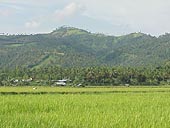|
| Baao, Camarines Sur, Philippines | |
|
Deforestation of Baao foothills may have also accelerated in this era especially after the transfer of the town center to its present location as more people cleared land and felled trees for their homes and farms. Coconut and abaca plantations were established to supply the increased demand for cooking and fuel oil and fiber for clothing. The American Occupation Era When the Spaniards left the Philippines for good after loosing the Spanish-American War and the Philippine Revolution of 1898, the Americans came to colonize the Philippines. They were under the guise of "benevolent occupation to civilize their little brown Filipino brothers" including the Baaoeños, as if we are all still running naked in the boondocks of Caranday. Civilization came in the form of the Krag rifle to kill the "insurrectos" and "bandidos" (names the American colonizers gave to the nationalist Filipinos who fought against them in the Filipino-American War ), the first public school system and the English language. But they also found good business exploiting the lumber, copra and abaca from Baao for export back to their homeland. The Japanese Occupation Era The Japanese briefly occupied Baao from 1942 to 1945 during the outbreak of the Second World War in the Pacific. Many townspeople evacuated to the hinterlands to avoid their new colonizers. Guerilla forces composed of Baaoeños, mostly loyal to the Americans, were organized especially when the war tides are turning against the Japanese forces, not to defend the country against all colonizers but to ensure the protection of American interests. The Japanese forces committed atrocities, especially when they found themselves on the loosing end of the war. Among these is the infamous Agdangan massacre where more than two dozen Baaeños from Agdangan lost their lives. The municipal hall was also burned down during these years of turmoil. The town's economy ground to standstill as agricultural production fell. Famine and epidemics broke-out. People were sometimes forced to eat namo, a poisonous wild yam, just to survive. Monetary inflation rose sky-high that buying a ganta of rice would need a basketful of Japanese money. The Post War Era The Second World War left the town and its people in shambles. Early in the post-war years, the Baaoeños spent most of their time rebuilding the town and its economy. The War Reparations Act provided some of the funds to finance reconstruction of destroyed and damaged infrastructure.
|
|
|
|


